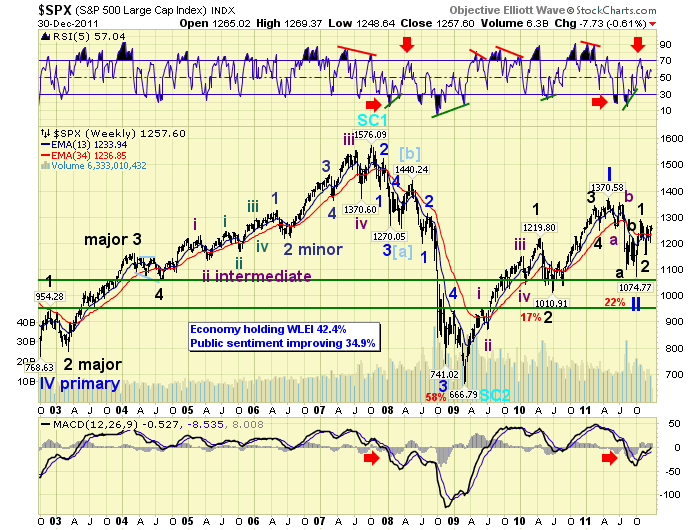Ten Themes for 2012
- Severe European Recession as the sovereign debt crisis escalates: Austerity measures in Italy, Greece, Spain, and Portugal plunges all of Europe into a major recession. Spain and Portugal will follow Greece into an outright depression.
- Political Crisis in Europe: French President Sarkozy loses to socialist challenger Francois Hollande. German Chancellor Angela Merkel’s coalition collapses. The Merkozy agreement is either modified to do virtually nothing or is not ratified at all. This chain of events will not be good for European equities or European bonds.
- Relatively Minor US Economic Recession: The US will not avoid a recession in 2012. Retail spending ran its course with the tail-off into Christmas of 2011. The Republican Congress has little incentive for fiscal stimulus measures in 2012 so do not expect any. However, with housing already limping along the bottom in terms of construction and investment (not prices), a US GDP decline will not be severe. The US may see a recession even if GDP barely drops. Certainly the US recession will be far less severe than the recession in Europe and Australia.
- Major Profit Recession in US: Profit margins in the US will be torn to shreds as businesses will be unable to reduce costs the same way they did in 2008 and 2009 (by shedding massive numbers of employees).
- Global Equity Prices Under Huge Pressure: Don’t expect the same degree of reverse decoupling of US equities we saw in 2011. The US economy will be better than Europe, but equities globally will take a hit, including the US. Simply put, stocks are not cheap.
- Fiscal Crisis in Japan Comes to Forefront: Japan’s fiscal crisis and debt to the tune of 200+% of GDP finally matters. The crisis in Japan will start out as a whimper not a bang, but will worsen as the year wears on. If Japan responds by monetizing debt, not a remote possibility at all, Japanese equities will massively outperform in nominal and perhaps even in real terms. “Real” means “yen-adjusted”, not “inflation-adjusted” terms.
- Few Hiding Spots Other than the US Dollar: US treasuries and German bonds were safe havens in 2011, but with yields already depressed don’t expect huge gains. Expect to see a strengthening of the US dollar across the board against all major currencies. Moreover, cash (one the most despised asset classes ever), may outperform nearly everything, even if the dollar goes virtually nowhere. Hiding places will be few and far between for much of 2012.
- US Public Union Pension Plans Under Attack: States finally realize the need to rein in pension plans much to the dismay of public unions. Social and economic tensions in the US rise.
- Regime Change in China has Major Ramifications: China will start a major shift from a growth model dependent on housing and infrastructure to a consumer-driven model. The transition will not be smooth. Property prices in China will collapse and commodity prices will remain under pressure.
- Hyperinflation Calls Once Again Will Look Laughable: Unless there is a major disruption in the Mideast (which I do not rule out by any means), oil prices will drop and food prices will follow. If so, we will once again see silly talk from the Fed about preventing “unwelcome drops in inflation”. As always, the deflation key is not prices at all but rather credit and credit marked-to-market. Expect credit in all forms to come under attack and expect junk bonds take a hit as well. By the way, regardless of what happens to oil prices, hyperinflation calls will look silly.
Addendum:
2011-12-30
Several people have asked me to comment on precious metals. I also wanted to mention trade wars and energy.
Trade Wars
Expect Global Trade Wars: Look for tit-for-tat trade wars to heat up in 2012 as noted previously in China to Impose Anti-Dumping Duties on GM; “Fair Trade” Idea is Self-Serving Scam; Proposal to Stop “Free Sunlight” Gains Support From Mitt Romney. Should Mitt Romney win the election, expect global trade to collapse in 2013. Trade wars will not be good for equity prices.
US Election
US Political Roadmap: If President Obama dumps Joe Biden for Hillary Clinton as his vice presidential candidate as Robert Reich suggests inMy Political Prediction for 2012: It’s Obama-Clinton, Obama will win re-election unless the Republican candidate is specifically Ron Paul. Clearly this is not an endorsement of Obama, it is a prediction. Some mistook my 2008 prediction for Obama as an endorsement. It wasn’t. I wrote in Ron Paul in 2008 and will do so again unless he is the nominee. If Ron Paul is the Republican nominee I think Paul would draw enough crossover votes from independents and Democrats who are sick of war and big government to win. If it’s Obama-Biden vs. Newt Gingrich or Mitt Romney then it’s too close to call.
Energy
Oil is a wildcard. My prediction is cooler heads prevail. However, the election is 11 months away and that is a lot of time for someone to get carried away. The odds the US initiates an attack on Iran under Ron Paul are virtually zero. Unfortunately the same cannot be said for any of the other major candidates. Should the US or Israel attack Iran (I do not believe the US will), then the price of crude will quickly skyrocket by $50 or more. Such an oil shock would immediately send the entire global economy into a severe recession.
Precious Metals
Precious Metals Roadmap: What follows is more of an approach than a prediction. Gold remains a much safer play than silver, something I have said for years. Technically silver is flirting with a breakdown of major support at $27. If that low does not hold, a decline to the low-to-mid $20’s is likely (something I said earlier this year when silver was near $50). I have no target for gold. The longer the US holds off quantitative easing and the ECB lets the sovereign debt crisis simmer without action, the bigger the potential drop in precious metals. Moreover, silver is likely to take a bigger hit than gold (percentage-wise) in a recession or global slowdown because silver is an industrial commodity and Chinese demand for industrial commodities is poised to plunge. Both gold and silver are more likely to be weaker earlier in the year as opposed to the second half given the Bernanke Fed does not look to launch QE3 any time soon. If the stock market and energy prices plunge in the first half of 2012, Bernanke will be more inclined to launch another QE program and that would be beneficial to precious metals.
Mike “Mish” Shedlock
http://globaleconomicanalysis.blogspot.com
Click Here To Scroll Thru My Recent Post List











